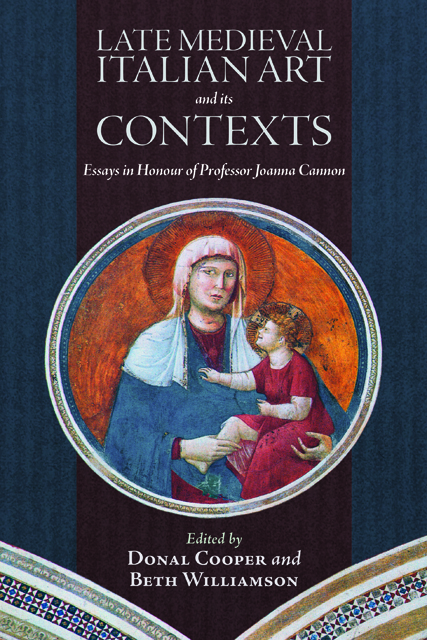Book contents
- Frontmatter
- Contents
- List of Illustrations
- List of Contributors
- Acknowledgements
- List of Abbreviations
- 1 Introduction: Circling Giotto
- 2 Holy Wood / ‘sacra tavola’: Saint Dominic and the Memory of Miracles in Bologna
- 3 The Sculpted Saint: A Statue of Saint Francis in Siena
- 4 Guccio di Mannaia and the Concept of a ‘Franciscan’ Chalice
- 5 ‘Speculum sine macula’: The Trittico di Santa Chiara in Trieste as an Object of Clarissan Devotion
- 6 The Siena Connection: A Franciscan Provincial Minister between Tuscany and Assisi at the Dawn of the Trecento
- 7 Simone Martini’s ‘Treaty with the House of Santa Fiora’ in Siena’s Palazzo Pubblico: Its Date and Significance
- 8 Crisis and Charity in Fourteenth-Century Florence: Ambrogio Lorenzetti’s Saint Nicholas Panels for San Procolo
- 9 Father of Light: Giotto and the Beatific Vision in the Baroncelli Chapel
- 10 Painter-Illuminator Workshops and the Church of San Giorgio a Ruballa: The Case of Bernardo Daddi and Pacino di Bonaguida
- 11 Patterns of Holiness: A Virgin Lactans in a Franciscan Context
- 12 A New Angle on Simone Martini’s Holy Family
- 13 Artistic Appropriation, Institutional Identity, and Civic Religion in Fourteenth-Century Siena: The Byzantine Treasury of the Hospital of Santa Maria della Scala
- 14 Visual Religious Education in Late Medieval Florence: Zanobi Perini, The Leggenda di Santo Tobia, and The Misericordia
- 15 Saints and Status in Late Medieval and Early Renaissance Florence
- Select Bibliography
- Publications by Joanna Cannon
- Index
- Tabula Gratulatoria
- Backmatter
15 - Saints and Status in Late Medieval and Early Renaissance Florence
Published online by Cambridge University Press: 20 December 2022
- Frontmatter
- Contents
- List of Illustrations
- List of Contributors
- Acknowledgements
- List of Abbreviations
- 1 Introduction: Circling Giotto
- 2 Holy Wood / ‘sacra tavola’: Saint Dominic and the Memory of Miracles in Bologna
- 3 The Sculpted Saint: A Statue of Saint Francis in Siena
- 4 Guccio di Mannaia and the Concept of a ‘Franciscan’ Chalice
- 5 ‘Speculum sine macula’: The Trittico di Santa Chiara in Trieste as an Object of Clarissan Devotion
- 6 The Siena Connection: A Franciscan Provincial Minister between Tuscany and Assisi at the Dawn of the Trecento
- 7 Simone Martini’s ‘Treaty with the House of Santa Fiora’ in Siena’s Palazzo Pubblico: Its Date and Significance
- 8 Crisis and Charity in Fourteenth-Century Florence: Ambrogio Lorenzetti’s Saint Nicholas Panels for San Procolo
- 9 Father of Light: Giotto and the Beatific Vision in the Baroncelli Chapel
- 10 Painter-Illuminator Workshops and the Church of San Giorgio a Ruballa: The Case of Bernardo Daddi and Pacino di Bonaguida
- 11 Patterns of Holiness: A Virgin Lactans in a Franciscan Context
- 12 A New Angle on Simone Martini’s Holy Family
- 13 Artistic Appropriation, Institutional Identity, and Civic Religion in Fourteenth-Century Siena: The Byzantine Treasury of the Hospital of Santa Maria della Scala
- 14 Visual Religious Education in Late Medieval Florence: Zanobi Perini, The Leggenda di Santo Tobia, and The Misericordia
- 15 Saints and Status in Late Medieval and Early Renaissance Florence
- Select Bibliography
- Publications by Joanna Cannon
- Index
- Tabula Gratulatoria
- Backmatter
Summary
As the heads of the Greek and Latin Churches sought to unite their respective institutions during the Council of Florence in 1439, they and their entourages were treated to elaborate, public displays of the Florentines’ devotion to two of their most important patron saints: John the Baptist, and the early Christian bishop, Zenobius (d. c. 424). On 26 April the council participants attended the translation of Saint Zenobius’s relics from the crypt of the medieval cathedral of Santa Reparata to a chapel dedicated to him in the east tribune of the new cathedral of Santa Maria del Fiore (Fig. 15.1). Slightly less than two months later, the same prestigious cohort witnessed the annual celebration of the Baptist’s feast on 23 and 24 June. The April and June events were celebrated with a great deal of pomp, and the visiting ecclesiastical dignitaries must have departed their host city with the impression that the Florentines accorded a similar amount and kind of attention to both of their saintly protectors.
One would never arrive at the same conclusion today. Since 1975, Saint Zenobius’s traditional feast of 25 May has been observed on 10 May, when its celebration is efficiently, if ahistorically, bundled with that of Florence’s other sainted (arch)bishop, Antoninus Pierozzi (1389–1459). The very modest recognition of Zenobius on that day, which consists of special masses and the display of the saint’s head reliquary (Plate XXII) near the Saint Zenobius Chapel, largely passes unnoticed. The feast of Saint John, in contrast, is celebrated from morning to night each 24 June with a procession, complete with a corps of drummers and the choreographed movements of costumed flag-bearers, Mass in the cathedral, a rousing game of calcio storico, and an impressive display of fireworks over the river Arno. The discrepancies in the degree to which each saint’s feast is presently celebrated in Florence have long found a parallel in the historical and art historical literature, which unequivocally privileges the place the civic patron, John the Baptist, occupied in Florentine devotions over that of the episcopal patron, Zenobius.
- Type
- Chapter
- Information
- Late Medieval Italian Art and its ContextsEssays in Honour of Professor Joanna Cannon, pp. 289 - 306Publisher: Boydell & BrewerPrint publication year: 2022



